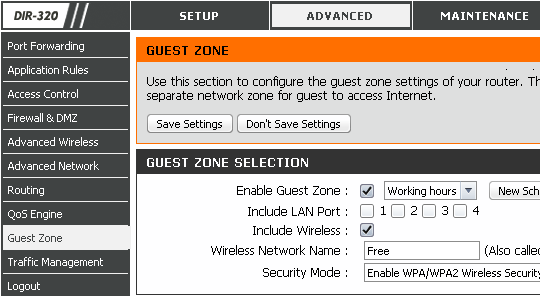Quantity of wireless access points is booming (in some places faster than in others, but still). I have covered my wireless router and it is perfect for my own use.
But other than personal use there is often need for public Wi-Fi access to Internet, that is safely separated from internal and private network. Some SOHO wireless routers started to include feature for that called guest zone.
What it does
Guest zone essentially creates separate network space. Computers connecting through guest zone will have access to router’s Internet connection, but no access to other PCs on LAN.
Usually there is also option to isolate guest clients from each other.

dlink_guest_zone
Setup
- First you need a router that has guest zone feature. I tested it on D-Link DIR-320 (curiously my DIR-400 doesn’t have it) so all settings are according to that model.
- Set up regular settings as usual, they are not connected to or affect guest zone usage.
- Locate guest zone settings, for D-Link they are in Advanced tab of administration interface.
- Enable guest zone for wireless interface (can also include LAN ports) and give it a name (SSID), it must be different from main SSID – they will co-exist nicely.
- Set up router’s IP for guests. For main this is usually 192.168.0.1 so for guests it should be something else like 192.168.1.1. DHCP will assign IPs from this zone to guest.
- Set up security for guest connections according to your requirements.
- You can set guest zone to only be active on schedule in specific hours.
- Don’t forget to save settings when done and wait for router to apply them.
- You can also restrict bandwidth guest zone can consume in traffic management.
Done. Router will now maintain two wireless networks at the same time. Native will act as part of regular LAN and guest zone will only have Internet access, but nothing more.
Overall
There are multiply ways to secure and set up public Wi-Fi access. Many of them require highly functional, but complex and expensive hardware. Guest zone feature is perfect replacement when number of connecting computers is low and can be found in relatively inexpensive SOHO routers.
Jim Sefton #
Rarst #
Jim Sefton #
Rarst #
Jim Sefton #
Rarst #
SpaceCadet0 #
Rarst #
Oliver Newell #
Rarst #
don #